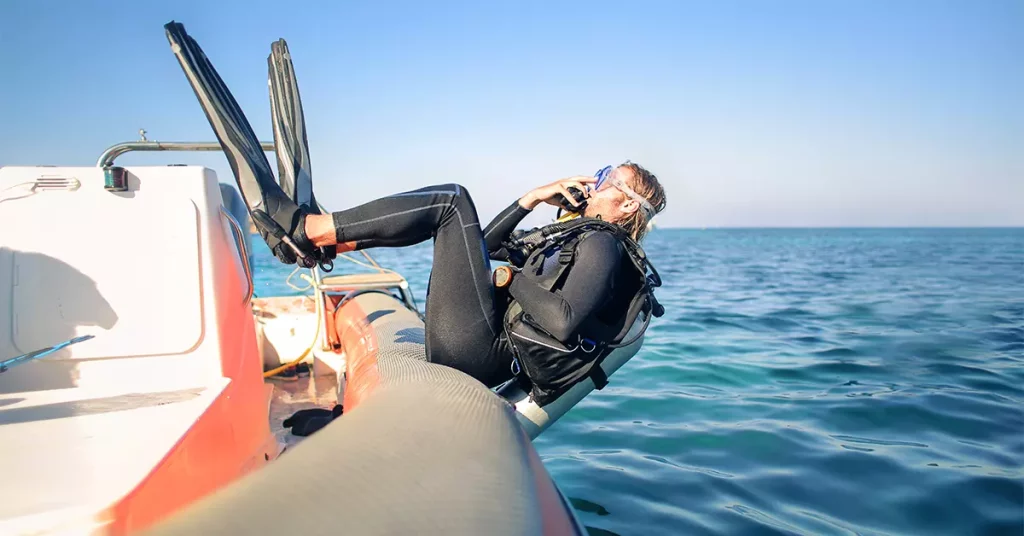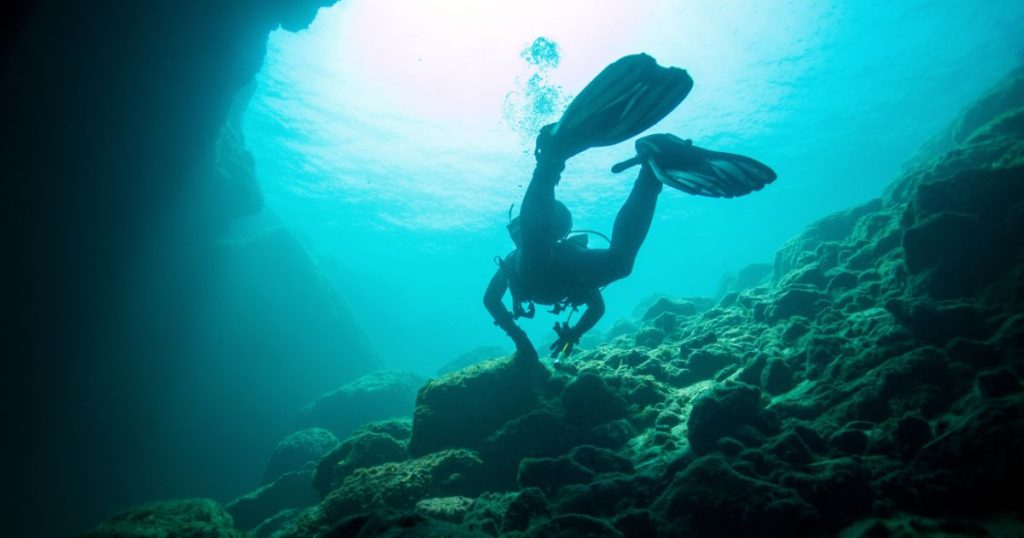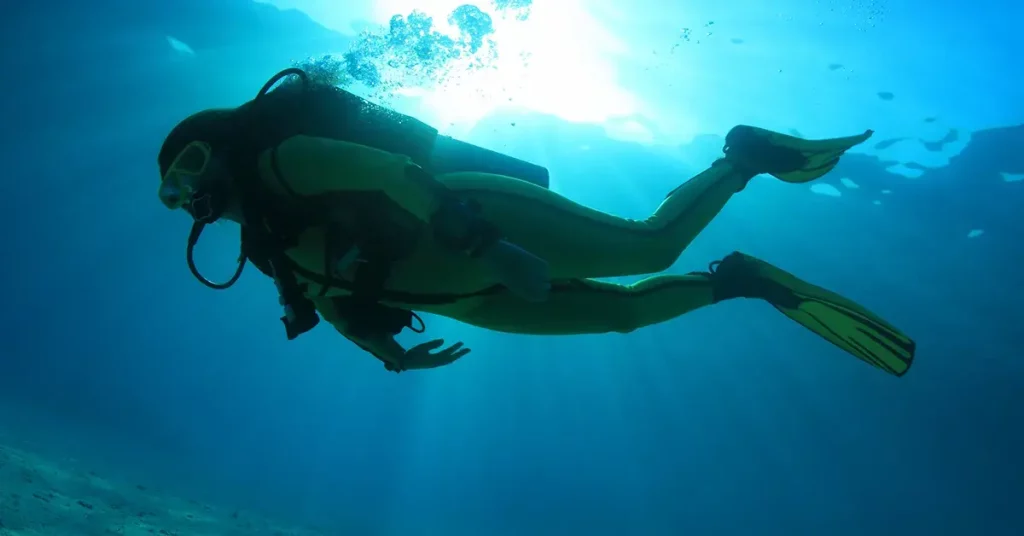When it comes to scuba diving, people often wonder “why do divers go in backwards” when they enter the water. If you have a general curiosity about scuba diving, here are the answers to the most common questions.
If you have never had the pleasure of going scuba diving, you might have some questions about how it works and why divers do the things they do. It can all seem a bit funny from the outside with the full-body wetsuits, giant fins, and bright snorkels.
Much thought has been put into making scuba diving as safe as possible, so all of these things have a purpose, believe it or not. You must take classes and earn a certification before scuba diving in open water.
Why Do Divers Go In Backwards into the Water with Their Scuba Gear?
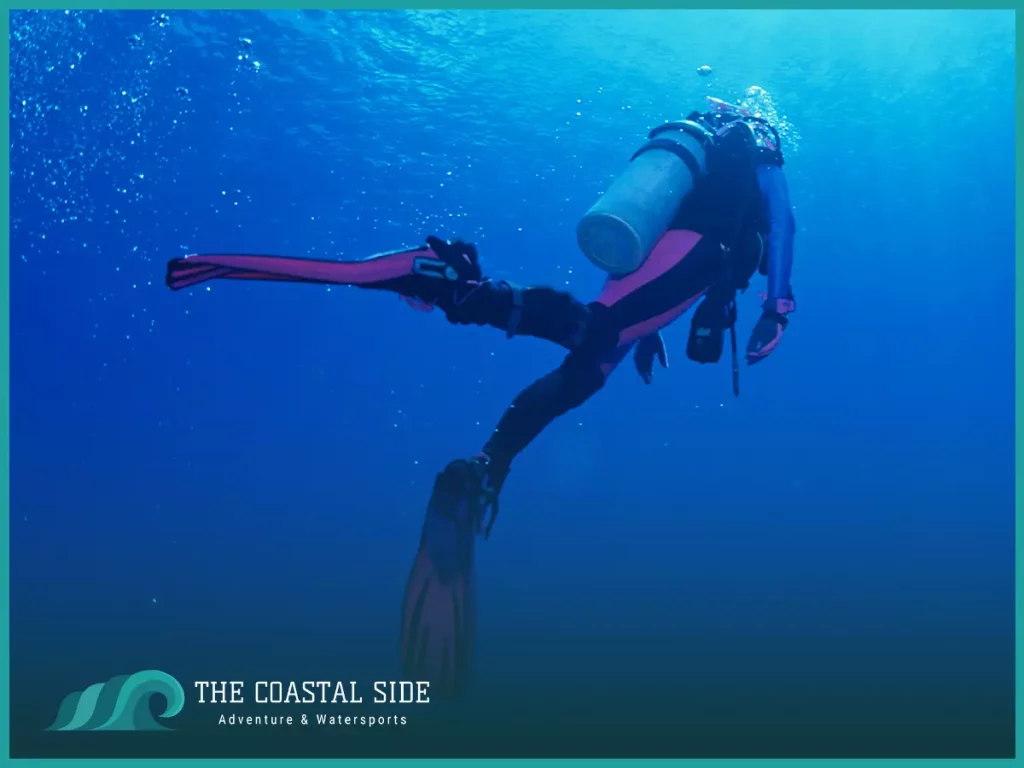
If you’re wondering why do divers go in backwards into the water, it’s because they use a back roll technique from larger boats for their safety. A scuba tank constructed from thick metal that withstands the water pressure is quite heavy. All the scuba gear weighs around 55 pounds (25 kg).
Thanks to buoyancy, this is not a problem once you enter the water. Once divers gear up, they will walk around backward because it is easier to do while wearing fins.
Scuba divers dive backwards often when entering water. It makes sense to enter the water backward if you are already walking backward. But it is also a better choice for several other reasons:
- The back roll entry is easier on your body.
- It is easier to hold onto goggles and other gear.
- Smaller boats don’t rock dramatically because of a splash.
The name for this rolling technique is a backward roll entry. The reason is that scuba divers dive backward or back-roll from smaller boats into the water.
What Is a Backward Roll In Scuba Diving?
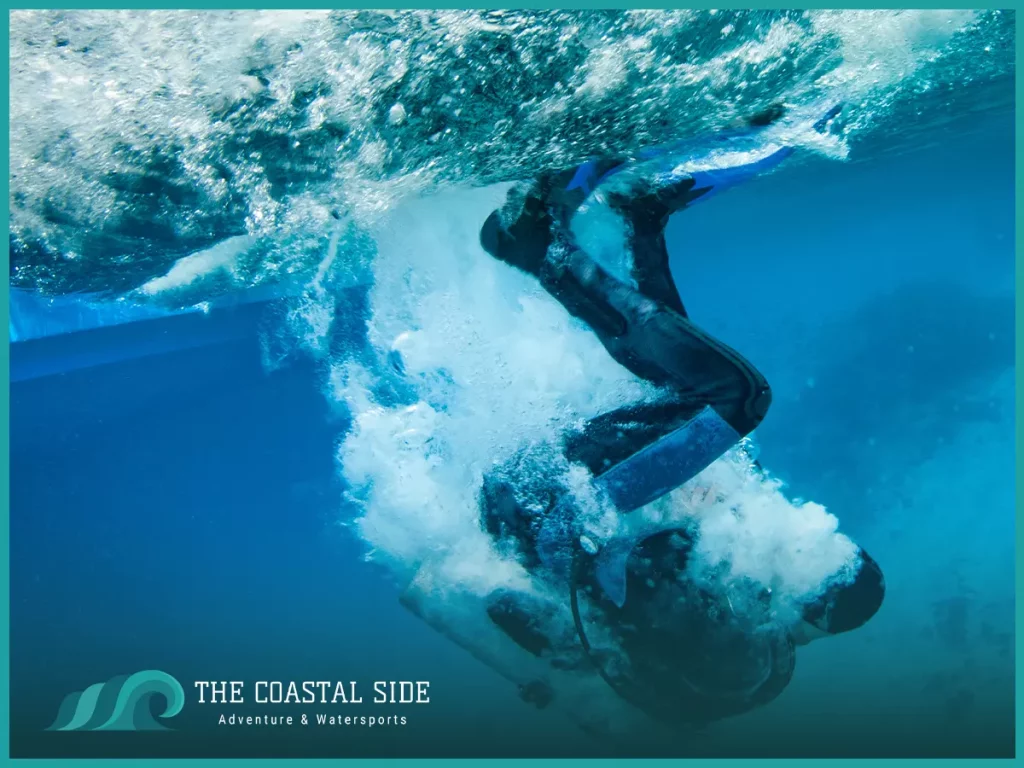
The backward roll is a safety technique used to enter the water with all of your diving gear. It is not a complicated maneuver, but you may need to practice it a few times to get the hang of it.
To perform this technique, you need to check that your diving gear is secure and ready for the dive. Next, head towards the side of the dive boat or a stable platform. Anywhere on the boat that is safe and clear for entry.
Once there, turn your back towards the water. Place your right hand on your regulator while using your fingers to secure your mask. Your left hand is usually holding any loose hoses at your side.
Then, tuck your chin against your chest and fall back into the water when you feel ready. You will be fully submerged. If you are doing this with an instructor, you can resurface and signal that everything is alright before descending.
Are There Other Ways for Scuba Divers To Enter the Water?
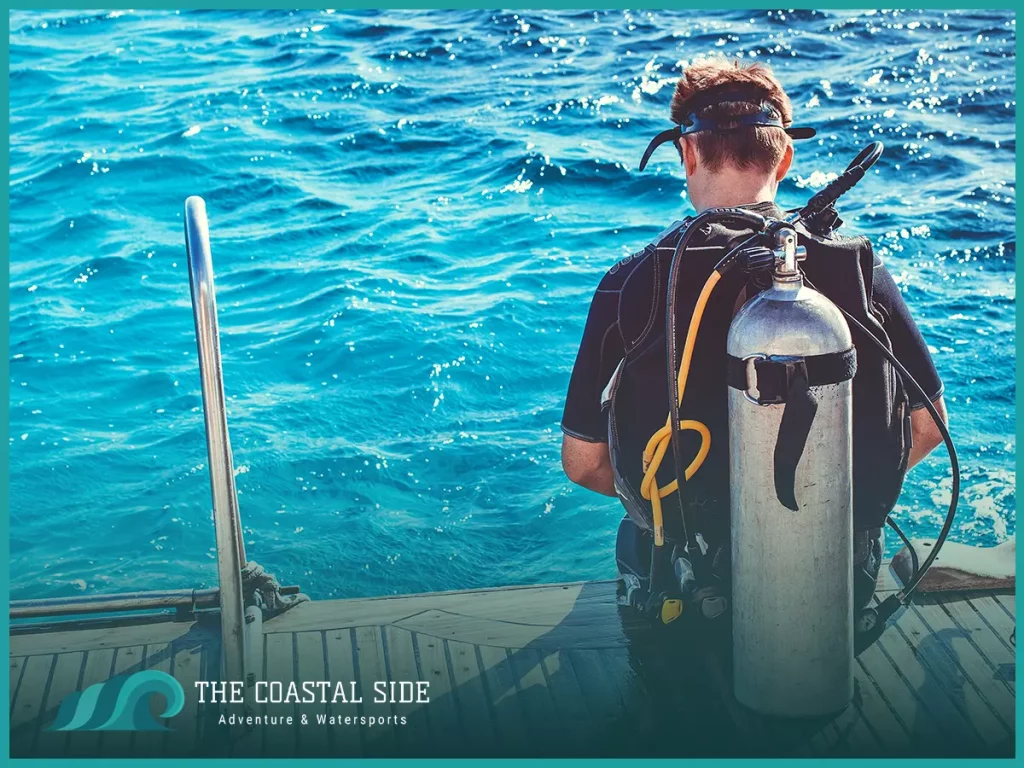
Yes, there are other safe ways to enter the water. The backward roll entry is the preferred method for most scuba divers, but other techniques are available to you.
The Seated Entry
The seated entry is a safe alternative entry technique if you have a smaller boat without a lot of space, a boat with an unstable platform, or a bad back. Make sure all of your dive gear is ready for the dive, and then head towards the edge of the small boat.
Partially inflate your buoyancy compensator (BC) and put on your mask and regulator. In a seated position with your bottom on the platform and your fins hanging into the water. Put your hands down flat on the platform, facing away from the water.
Turn so that you are facing the boat as you lift yourself. Both hands should be flat on the platform again while your body is facing the vessel. Hold yourself steady on the platform and gently lower yourself into the water.
If done correctly, you will make little to no splash upon entry.
The Giant Stride
The giant stride entry is what it sounds like: you take a giant stride off the boat into the water. The giant stride should be executed from a dive boat with a stable platform to ensure safety.
If you can stand on the edge of the platform and have your fins stretch out over the edge unobstructed, then this is an option for you. First, make sure the water is clear from any people or debris. Next, prepare for the stride in the same manner as the backward roll.
Put the regulator into your mouth and secure it with your right hand. Use your fingers to hold your mask. Take a giant stride off of the platform and into the water. Be sure to take a large enough stride to avoid hitting the side of the boat.
Can Scuba Divers Enter the Water From the Shore?
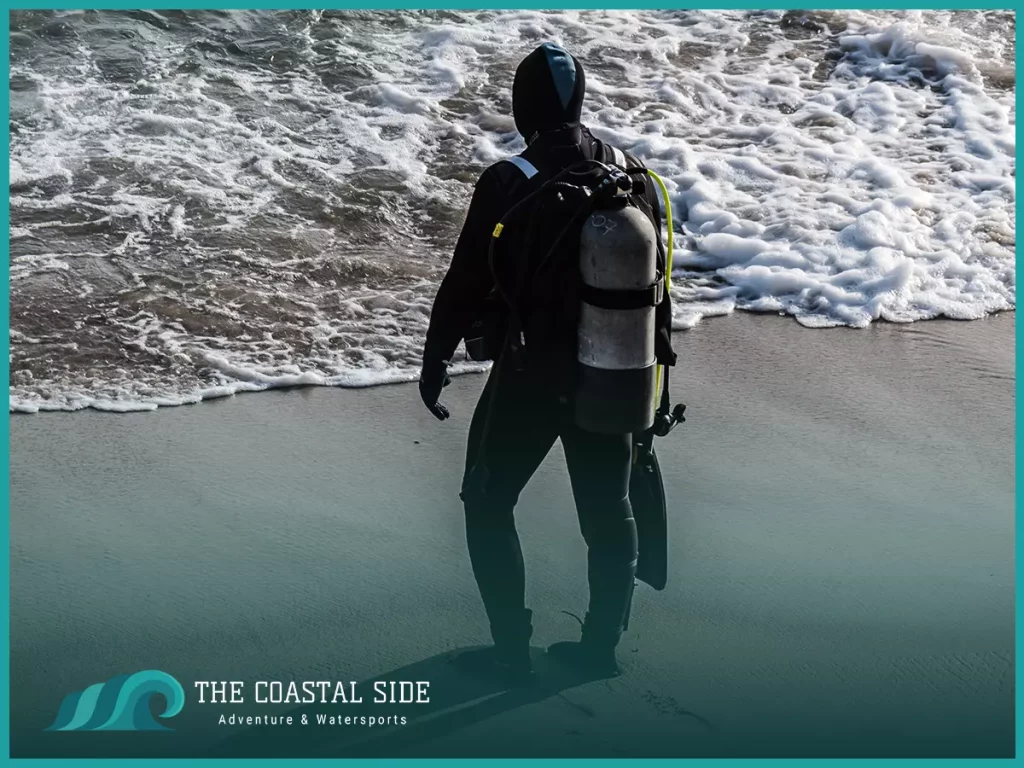
You can enter the water from the shore, but it can be riskier than entering from a boat. The conditions of a beach that would be risky for a swimmer are also a risk for a diver. You can get caught in the riptide or encounter rocky shore and pounding surf.
It is not always dangerous, but you should carefully make a plan so that you do not put yourself into a life-threatening situation. Even if you made a plan in advance, you should assess the current weather conditions.
Once you have found a safe spot for the shore entry, try to find something to mark it to know where to exit. All of your diving equipment should be on, except for your fins. Carry them underneath your arm.
Walk into the water with your mask and regulator on in case you become submerged unexpectedly. Wade until the water reaches chest level, then put your fins on. Then inflate your BC and swim backward until the water is deep enough for the descent.
If you prefer, you can enter the water with your fins on, you’ll need to walk backward to maintain your balance until you reach deep enough water to inflate your BC and swim backward.
Divers do not have the luxury of using other entry techniques like the giant stride, seated entry, or backward roll on a shore entry. Scuba divers with diving experience may try another entry method but run the risk of a fall forward instead of the ideal fall backward.
What Happens if Scuba Divers Enter the Water Incorrectly?
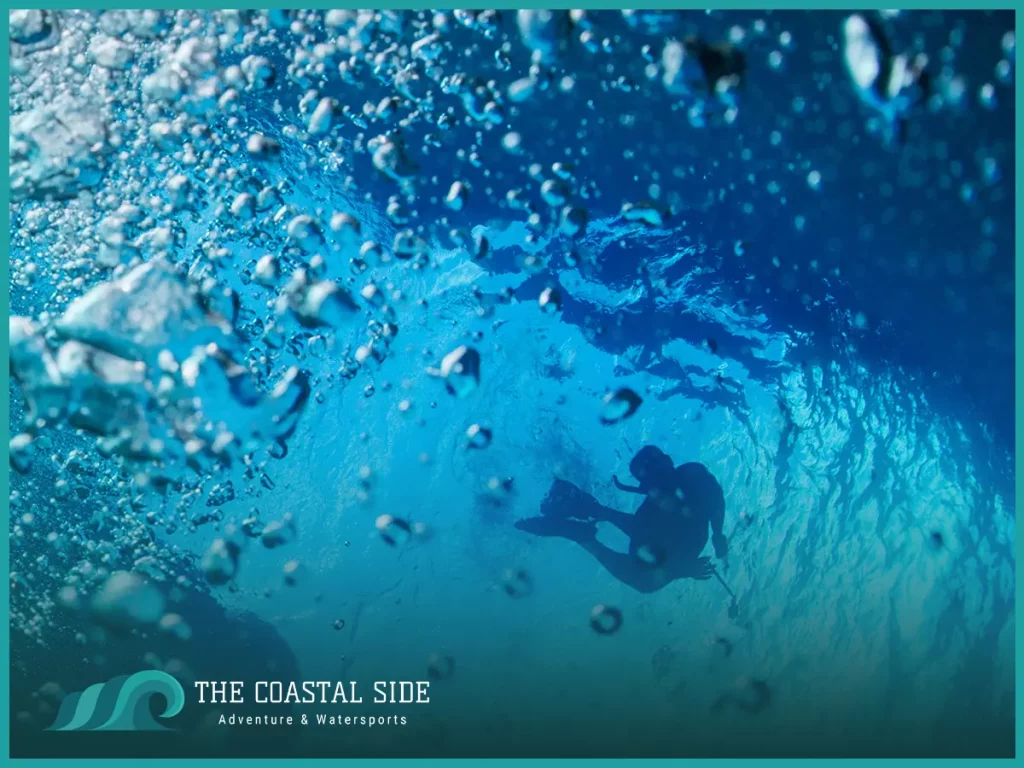
If you incorrectly perform one of the entry methods, you could lose your scuba equipment or injure yourself. Some ways of entering the water incorrectly from a boat would be doing a belly flop, a flip, diving headfirst, or falling backward.
There are other incorrect entry techniques, these are just a few examples for a larger boat or a smaller boat. Doing a belly flop hurts without any dive gear on, so diving with heavy scuba gear would hurt even worse.
It would be dangerous to do a flip with scuba gear on because it’s harder to control your body with the extra weight, especially on an unstable surface like those on rigid inflatable boats. That could potentially lead to you hitting the side of the boat and injuring yourself.
Diving headfirst or falling forwards into the water could knock your mask strap off or let water into it. It could also slam your face mask or regulator into your face, or damage vital equipment like your tank valve.
What Are Some Basic Hand Signals for Scuba Divers?
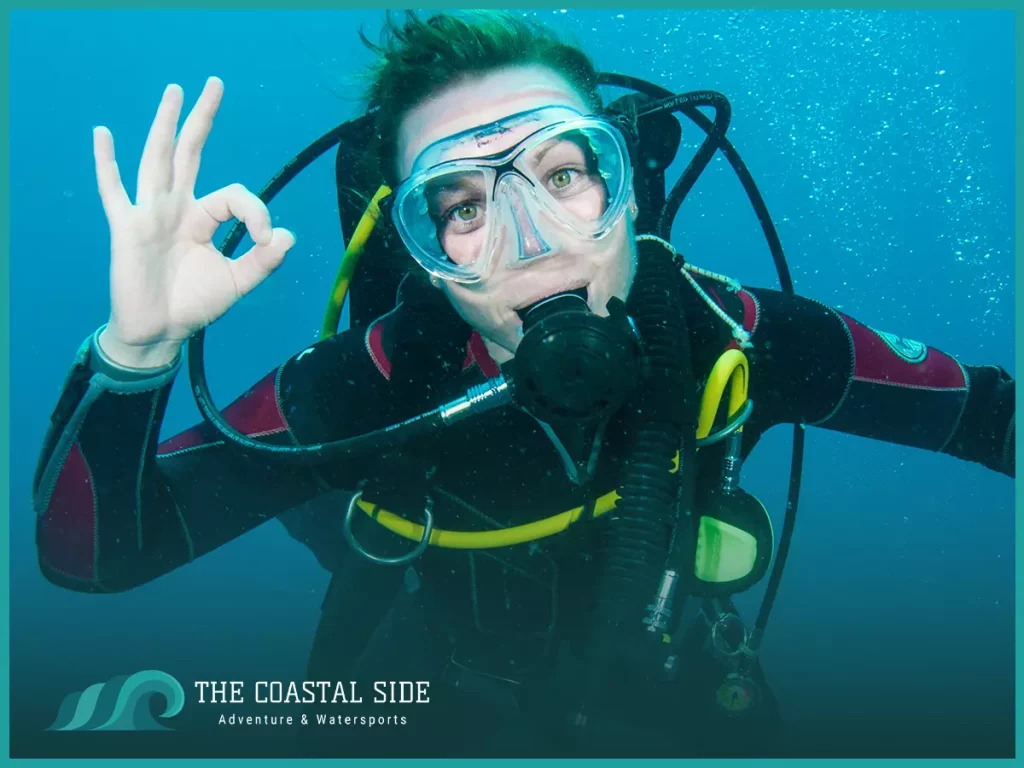
When you take classes to become a certified scuba diver, you’ll learn a lot of useful things about safety and science, including basic hand signals that’ll allow you to communicate with other divers underwater.
It’s possible to buy underwater writing devices, but it’s still handy to know these signals. Not everyone will have a writing device, and you may lose yours.
There are over one hundred hand signals, so you’re only going to hear about some common ones. The good news is that you may already be familiar with some of these.
The OK
You do it by joining your thumb and index finger to form a loop and then extending the other three fingers up.
This is one of the first signals that divers learn. It can be used to ask if someone is okay and to answer that question. This shouldn’t be confused with the thumbs up, which means something different.
Not OK/Problem
You do this signal by holding your hand open and flat. Face it downwards and then rotate it slowly from side to side. You should make this signal and then try to point to the source of the problem.
Up/End The Dive
To show that you want to end the dive, give the thumbs up. This is why you can’t use a thumbs up to let someone know that you’re okay.
Down/Descend
To perform this signal, do a thumbs down. It means that you’re ready to go deeper. It doesn’t mean that you’re not okay or that there’s a problem.
Wrap Up
Learning to scuba dive can open up new worlds for you. It’s a fantastic skill to learn with many benefits and you can do it from anywhere in the world. With a little preparation, you can have an unforgettable experience anytime you like. Understanding why do divers go in backwards into the water is the first step to enjoying this new hobby.

